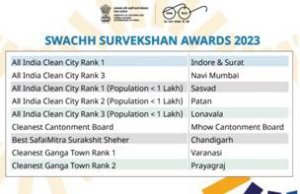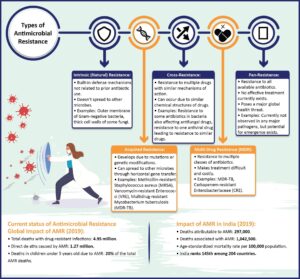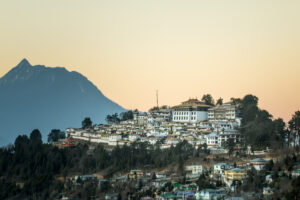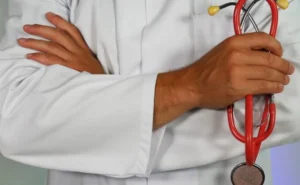Table of Contents
Direct Tax Collection
Context: India’s net direct tax revenue reached ₹14.7 lakh crore surpassing 80% of the annual target and marking a 19.4% increase compared to the same period in 2022-23.
Growth in India’s Direct Tax Collections
- Overall Growth in Tax Collection: India’s net direct tax collection rose by 19% to ₹14.71 lakh crore in the current fiscal. The gross collection was 24.58% higher than the corresponding period of the last year.
- Net Collection Post Refunds: The direct tax collection, after accounting for refunds, stood at ₹12.31 lakh crore, marking a 19.55% increase compared to the same period in the previous fiscal year. This represents 86.68% of the total budget estimates of direct taxes for FY 2022-23.
- Growth in Corporate Income Tax and Personal Income Tax: The growth rate for Corporate Income Tax (CIT) was 19.72%, and for Personal Income Tax (PIT), including Securities Transaction Tax (STT), it was 30.46%. After adjusting for refunds, the net growth in CIT collections was 18.33%, and that in PIT collections was 21.64%.
- Increased Refunds: Refunds amounting to ₹2.40 lakh crore were issued from April 1, 2022, to January 10, 2023, which is 58.74% higher than the refunds issued during the same period in the preceding year.
- Budget Estimates and Fiscal Deficit: The government had set a target to collect ₹18.23 lakh crore from direct taxes, which is higher than ₹16.61 lakh crore collected in the last fiscal. The fiscal deficit is estimated at 6% of the GDP for the current financial year.
- ICRA Report Projections: According to an ICRA report, the direct tax and central GST collections are expected to exceed the budget estimates for 2023-24 by ₹1 lakh crore and ₹10,000 crore, respectively.
We’re now on WhatsApp. Click to Join
What Is Direct Tax?
- Direct tax is a kind of tax paid directly by an individual or organisation to the authority that imposes it.
- Both the responsibility for paying the tax and its effects fall on the same person or organisation.
- The burden of a direct tax cannot be transferred to someone else or another entity.
- Direct taxes are progressive, meaning the tax liability increases with the income of the person or entity.
- In India, direct taxes are overseen by the Central Board of Direct Taxes (CBDT).
- Examples of Direct Tax in India: The CBDT administers several types of direct taxes, including:
- Income Tax
- Corporate Tax
- Capital Gains Tax
- Securities Transaction Tax
- Minimum Alternate Tax
Trend of Direct Tax Collections in Last Years
| Financial Year | Corporate Tax | Personal Income Tax | Other Direct Taxes | Total (in Rs. crores) |
| 2015-16 | 61.09% | 38.77% | 0.15% | 741,945 |
| 2016-17 | 57.07% | 41.13% | 1.80% | 849,713 |
| 2017-18 | 56.96% | 41.89% | 1.14% | 1,002,738 |
| 2018-19 | 58.32% | 41.59% | 0.08% | 1,137,718 |
| 2019-20 | 53.00% | 46.90% | 0.10% | 1,050,681 |
| 2020-21 | 48.32% | 51.48% | 0.20% | 947,176 |
| 2021-22 | 50.41% | 49.32% | 0.27% | 1,412,422 |
Atal Setu
Context: Prime Minister Narendra Modi has inaugurated the Mumbai Trans Harbour Link (Atal Setu Nhava Sheva Sea Link).
About Mumbai Trans Harbour Link (Atal Setu Nhava Sheva Sea Link)
- Length and Structure: The MTHL is India’s longest sea bridge, stretching 22 kilometres. It comprises a twin-carriageway, six-lane bridge traversing Thane Creek in the Arabian Sea.
- Composition: This massive structure includes a 16.5 km sea link and additional viaducts on land at both ends, cumulatively measuring 5.5 km.
- Purpose: The primary goal of the MTHL is to enhance connectivity within the Mumbai Metropolitan Region, which includes Mumbai, Thane, Palghar, and Raigad districts. The project aims to spur economic growth in this region.
Benefits
- Improved Connectivity: It will connect Sewri in Mumbai to Chirle in Raigad district, significantly easing travel across these regions.
- Reduced Travel Time and Congestion: The link is expected to drastically reduce travel time and alleviate congestion on the current route via the Vashi bridge.
- Enhanced Access to Key Areas: It will bolster connectivity between South Mumbai and key areas such as the upcoming Navi Mumbai International Airport, the Mumbai-Pune Expressway, the Mumbai-Goa Highway, and other central hinterland regions.
- Access to Major Port: The bridge will also facilitate better access to the Jawaharlal Nehru Port, enhancing logistic operations.
Swachh Survekshan Awards 2023
Context: Recently the result of the Swachh Survekshan Awards 2023 was announced by the President of India.
About Swachh Survekshan Awards
- Nature of the Survey: It’s an annual assessment focused on evaluating cleanliness, hygiene, and sanitation in cities and towns across India.
- Inception and Objective: Launched in 2016, it forms a part of the Swachh Bharat Abhiyan, which aims at achieving a clean and open defecation-free India by October 2, 2019.
- Conducting Bodies: The Ministry of Housing and Urban Affairs (MoHUA) conducts the survey, with the Quality Council of India (QCI) as its implementation partner.
- Evaluation Parameters: Cities are ranked based on three primary criteria: service level progress, citizen feedback, and certification.
- Annual Themes: For 2023, the theme is ‘Waste to Wealth’, and for 2024, it is ‘Reduce, Reuse, and Recycle’.

- 2023 Awards Highlights:
- State-wise rankings: Maharashtra topped, followed by Madhya Pradesh and Chhattisgarh.
- City-Wise ranking: Indore (For seventh consecutive year) & Surat.
Are Antibiotics Over- Priced In India?
Context: A National Centre for Disease Control (NCDC) study of about 10,000 hospital patients across India reveals that 55% received antibiotics as a preventive measure which highlights concerns about drug-resistant pathogens in the country.
About AntiMicrobial Resistance
- Antimicrobial resistance (AMR) is the ability of microbes (including bacteria, viruses, fungi, and parasites) to resist the effects of antimicrobial drugs. This means that the drugs become ineffective and are unable to treat infections caused by these resistant microbes.

About the National Centre for Disease Control (NCDC) in India
- Organisational Structure: NCDC operates under India’s Directorate General of Health Services, part of the Ministry of Health and Family Welfare. The Director, a Public Health sub-cadre officer of the Central Health Service, leads the institute both administratively and technically.
- Historical Evolution: Originally established as the Central Malaria Bureau in Kasauli, Himachal Pradesh, in 1909, the institute has undergone several transformations.
- It was renamed the Malaria Survey of India in 1927, moved to Delhi in 1938 as the Malaria Institute of India, and later, due to the success of the National Malaria Eradication Programme, expanded to include other communicable diseases, becoming the National Institute of Communicable Diseases (NICD) in 1963.
- Transformation in 2009: In 2009, the NICD was rebranded as the National Centre for Disease Control to take on a broader role in controlling emerging and re-emerging diseases.
- Headquarter: New Delhi.
- Primary Functions: The centre serves as a pivotal agency for disease surveillance, aiding in the prevention and control of communicable diseases across the country.
- It collaborates with State Governments in disease surveillance, outbreak investigation, and rapid response to manage outbreaks.
- Focus on Antimicrobial Resistance: NCDC addresses the growing concern of Antimicrobial Resistance (AMR), offering insights and strategies to combat its far-reaching impacts.
- Support and Capacity Building: It provides referral diagnostic support, capacity building, and technical assistance to States and Union Territories in India, enhancing their capabilities in managing communicable diseases.
International Court Of Justice
Context: South Africa claims Israel has breached the 1948 Genocide Convention in its war on Gaza. Currently, the Israel is facing accusations of genocide in the International Court of Justice.
About International Court Of Justice
- Principal UN Judicial Organ: The ICJ is the main judicial body of the United Nations.
- Establishment: It was established in June 1945 by the United Nations Charter and started functioning in April 1946.
- Location: Peace Palace in The Hague, Netherlands (only one of the six principal UN organs not located in New York, USA.)
- Public Hearings: All hearings at the ICJ are public.
- Official Languages: The Court conducts its proceedings in English and French.
- Functions:
- Case Types: The ICJ deals with legal disputes between States (contentious cases) and advisory opinions on legal questions from UN organs and specialised agencies.
- Participation in Contentious Cases: Only member States of the UN or those that have accepted the Court’s jurisdiction can participate in contentious cases.
- Advisory Proceedings: Only five UN organs and 16 specialised agencies have the privilege to request advisory opinions.
- Binding Nature of Judgments: Judgments in contentious cases are final and binding on the parties involved, without the right to appeal.
- Advisory Opinions: Unlike judgments, advisory opinions of the ICJ are not legally binding.
- Legal Basis for Decisions: The ICJ bases its decisions on international law, including international conventions, customs, principles, judicial decisions, and scholarly writings.
- Composition:
- The Court consists of 15 independent judges from different countries, elected for nine-year terms by both the UN General Assembly and the Security Council.
- Election Process: Judges must receive an absolute majority of votes in both the General Assembly and the Security Council to be elected.
- Renewal of Composition: Every three years, one-third of the Court’s composition is renewed, and judges are eligible for re-election.
- Independence of Judges: Judges do not represent their own countries or any other State and pledge to perform their duties impartially and conscientiously.
Congo River
Context: The Congo River has reached its highest levels in over six decades leading to floods in the Democratic Republic of Congo and Congo Republic. It has resulted in the deaths of over 300 people in recent months.
About Congo River (Or Zaire River)
- Length and Ranking: The Congo River stretches approximately 2,900 miles (4,700 kilometres), making it Africa’s second-longest river after the Nile and the world’s ninth-longest.
- Name Origin: The river’s name is derived from the historic Kongo Kingdom located near its mouth.
- Geographical Reach: This river system traverses several African countries, including the Republic of the Congo, the Democratic Republic of the Congo, the Central African Republic, Zambia, Angola, Cameroon, and Tanzania.
- Source and Course: The Congo River originates as the Chambeshi River in Zambia’s highlands, between Lakes Tanganyika and Nyasa, at an elevation of 5,760 feet (1,760 metres).
- It follows a large counterclockwise arc, crossing the equator twice and eventually flowing into the Atlantic Ocean at Banana in the Democratic Republic of the Congo.
- Depth and Discharge: Renowned for being the world’s deepest river, the Congo reaches depths over 750 feet (230 metres).
- It also boasts the world’s second-largest river flow, with a discharge of 1.5 million cubic feet per second.
- Watershed and Drainage Area: The river drains a vast area of 3.7 million square kilometres (1.4 million square miles), known as the Congo Basin.
- Ecosystem: The Congo Basin is predominantly covered by extensive tropical rainforests and swamps, constituting Central Africa’s major rainforest region.
- It is the world’s second-largest rainforest, surpassed only by the Amazon Rainforest.
- Major Tributaries: Some of its main tributaries include the Ubangi, Sangha, and Kasai rivers.


 Monasteries in India: List of Major and ...
Monasteries in India: List of Major and ...
 National Doctor’s Day 2025: History, T...
National Doctor’s Day 2025: History, T...
 Bonalu Festival 2025: Date, History, Rit...
Bonalu Festival 2025: Date, History, Rit...





















